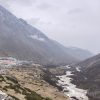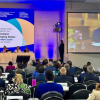Thursday, May 30, 2024
News and Views from the Global South
ENVIRONMENT-CHILE: Gov’t Continues to Push for Aluminium Plant
María Cecilia Espinosa
- Environmentalists in Chile are fighting a new offensive by the government to revive a plan to build an aluminium smelter in a pristine wilderness area in the southern part of the country, after the foreign mining company involved pulled out of the project.
Although Canadian mining and minerals giant Noranda officially withdrew its plans to build the Alumysa plant in the southern Chilean province of Aysen, some 1,500 kms south of Santiago, last August, the centre-left coalition government of President Ricardo Lagos is attempting to amend a local law on environmental impact studies to make it possible for Noranda to renew its involvement.
The 2.75 billion dollar Alumysa project would have been the largest private investment in the history of Chile, and by far the most ambitious industrial development project in the southern region of Patagonia, where Aysen is located.
Chile’s Patagonia region, which is home to just 87,000 of the country’s 16 million people, boasts one of the last extensive temperate coastal rainforests in the Americas.
With the backing of parliamentary Deputy Alejandro Navarro of the co-governing Socialist Party, a coalition of local environmental groups has filed a legal motion with the comptroller-general’s office.
The coalition, the Citizens’ Committee for the Defense of the Aysen Life Reserve, wants the comptroller-general’s office to declare the government’s attempt to simplify the procedures required by Chile’s law on environmental impact assessments illegal.
Aluminium smeltering is the chemical process by which alumina (aluminium oxide) is produced from bauxite, the basic aluminium- bearing ore. In the case of the massive aluminium smelter and hydroelectric project known as Alumysa, the alumina would have been imported from Australia, Brazil and Jamaica, to take advantage of Aysen’s enormous hydropower potential.
But the Aysen Life Reserve coalition argues that the plant would cause irreversible damage to the rivers, flora and fauna of that region, where the green forested Andean foothills sweep down to the sea.
The damages would include the destruction of pristine lakes, over 10,000 hectares of temperate rainforest, and the habitat of endangered species of animals and plants, according to Jenia Jofré, director of the National Committee for the Defence of Flora and Fauna (CODEFF), Chile’s oldest environmental organisation, which forms part of the Aysen Life Reserve coalition.
Noranda officially withdrew from the Alumysa project on Aug. 19, which put an end to the environmental impact study it was carrying out, before it was completed.
IPS was unsuccessful in its attempts to obtain an interview with Noranda officials.
But Robert Biehl, the managing director of the Alumysa project, said at the time that the company’s decision to withdraw ”was based on the announcement by Chilean government authorities (through the National Environment Commission) requiring a relocation of the smeltering plant, and the establishment of clear regulations for the zoning of the coastal area in Chacabuco bay.”
Biehl described Alumysa as ”a sustainable development project that abides by Chile’s regulations on emissions as well as international standards,” and said it would have inaugurated ”a new era of effective, exhaustive enforcement of environmental controls on productive activities in Aysen.”
The executive complained that there was ”an orchestrated campaign against Alumysa,” and protested pressure against the project from the salmon industry, which he deemed ”unacceptable,” arguing that ”at this time such controls do not even exist, and the salmon industry’s grave shortcomings in that respect are well-known.”
Salmon farms, tourism, and industrial and small-scale fishing provide around 20,000 jobs – 20 times more than the total number Alumysa would have offered – in the area.
If the government is successful in its attempt to amend the law on environmental impact studies, which applies to all investment projects in Chile, that would favour Noranda by shortening and simplifying the requirements that the company would have to meet if it decided to push ahead with the Alumysa project.
Activists complained that Economy Minister Jorge Rodríguez said ”part of Noranda’s problems with the Alumysa project involve the lack of clear regulations regarding the use of Chile’s shoreline,” but the problem would soon be overcome because ”Noranda is a very serious company, which already operates in Chile,” and ”we want it to continue investing here.”
Noranda owns mining interests in Chile, like the Alto Norte copper smelter in Antofagasta, in the north.
The head of the National Environment Commission, Gianni López, argued that if the Canadian mining company were to propose relocating the projected smeltering plant, it should be allowed to get past the phase involving the presentation of a new environmental impact study faster than the first time it presented the project.
A working group made up of Rodríguez and the secretary-general of the presidency, Francisco Huenchumilla, a government minister, has been set up with the aim of getting the derailed project back on track.
”The position that the government is taking is not appropriate, because a government minister cannot under any circumstances simultaneously judge and form part of the future regional development of Aysen,” Rodrigo Herrera, the activist in charge of forests in the Chilean branch of the international environmental watchdog Greenpeace, commented to IPS.
The question must be carefully evaluated, said the activist, who added that it is regrettable that Chilean authorities ”are acting without first becoming familiar with the details of the impact that Alumysa would have in the region.”
The original idea was to build the smelter near Puerto Chacabuco, the main port of the Aysen region, located 14 kms from the town of Puerto Aysen. The project would include six dams, three hydropower plants, an industrial waste facility, 79 kms of power lines, the construction and upgrading of 94 kms of roads, and expanded port facilities in Chacabuco bay.
The industrial complex would produce ”around 660,000 tons of waste a year, as well as 980,000 tons of carbon dioxide, over a 50-year period – the useful life of the plant,” said Herrera.
”The question we are asking is why Noranda doesn’t install the plant in Canada,” he said.
Herrera and other environmentalists say the transnational corporation wants to take advantage of cheap local labour and lax enforcement of Chile’s environmental regulations.
According to Manuel Baquedano, president of Chile’s Institute of Political Ecology (IEP), Noranda ”has an appalling environmental record,” and has already been forced to pay two million dollars in compensation for damages to human health and the environment in the United States.
But Biehl said the environmental impact study carried out by his company was ”the most complete ever presented in Chile, and was backed by the experience of more than 50 national and foreign experts,” who, he said, verified that the project would have amply lived up to the country’s environmental standards.
The authors of the company’s environmental impact study maintained that there would be no ”major impact,” even though they stated that ”around 9,600 hectares” of forests would be flooded, leading to ”the loss or alteration of habitat.”
But the study further stated that the flooding would lead to ”an increase in habitats for the Cuervo River fisheries, an expansion of wetland and lake habitats, greater opportunities for tourism, and reforestation on historically degraded land.”
The coordinator of the Aysen Life Reserve coalition, Flavia Liberona, underlined to IPS the role played in the campaign against Alumysa by local and regional social organisations, which ”have taken part in meetings outside of Chile and handed in observations on the environmental impact study at the time.”
But she admitted that even through close contact with local residents in Aysen, it was difficult to ascertain whether those living near the spot where Alumysa was to be built were in favour of or opposed to the project.
In the city of Puerto Aysen, people are not well informed about the project, and see it mainly as an ”employment alternative” to the salmon industry, said Liberona.
Puerto Chacabuco and Puerto Aysen draw tourists from the region and overseas, and provide boat services offering visitors day and overnight tours of the area’s spectacular fjords.
”The Alumysa project is a tyrannosaurus rex in paradise,” said Peter Hartmann, director of CODEFF’s Aysen office, who added that the project would have involved the damming of ”three pristine rivers, and the construction of a 116-metre high dam on one, which would practically dry it up.”
He said the waste produced by the plant would pollute the area’s fresh water as well as marine environments, thus hurting both the salmon industry and tourism.
According to the Aysen Life Reserve coalition, in the Blanco River and Caro Lake zones, the dams would pose a threat to two particularly valuable endangered species: the rare ”huemul”, or south Andean deer, which is featured on the national coat-of-arms, and the ”gato colo colo”, one of the country’s few species of wildcats.
Herrera told IPS he hoped the government would not only think about ”the 2.75 billion dollars that an investment like Alumysa would bring in,” but that it would also consider establishing some form of protection for the wilderness area, which, he argued, would not run counter to coming up with alternatives for sustainable development in the region.
He stressed that he was not opposed to progress and development in Chile, but that the installation of the Alumysa plant ”would damage one of the most untouched areas” of this Southern Cone country.
Herrera also noted that the company itself had admitted that ”only 10 percent of the profits produced by Alumysa would remain in Chile, while the rest would go to Canada.”
The plans for the smelter involved the production of 440,000 tons of aluminium bars a year, and the importation of 846,000 tons of alumina, 146,000 tons of calcinated coal coke, 43,500 tons of tar, as well as diesel fuel and gas.

 Print
Print



